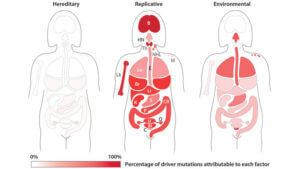Cristian Tomasetti and Burt Vogelstein at Johns Hopkins published a similar study in 2015 and were met with an outcry. Cancer experts worried that people would forgo important lifestyle factors like quitting smoking or wearing sunscreen if they heard that the majority of cancers are completely random and therefore unpreventable. If so many cancers are going to develop inevitably, why even try to reduce one’s risk? From Bloomberg:
For decades, the public has been warned of the link between exposure to all sorts of toxins and cancer. But according to a new study published on Thursday in Science, two-thirds of the gene mutations that cause the dreaded affliction in humans aren’t driven by the environment or even hereditary factors. They are the result of random DNA replication errors—or, as one of the researchers put it, “bad luck.”
Other analyses have called the study’s conclusions into question. Ed Yong, writing in the Atlantic, laid out the background of the authors’ first study, the blowback it faced, and what the study truly says about cancer-causing mutations: They’re hard for most people to wrap their heads around:
That paper was itself criticized for a slew of methodological flaws, and spawned more than a hundred rebuttals. Its authors are now back with a follow-up, which reads like a weird blend of doubling-down, clarification, and mea culpa. Although they’ve gone some way towards addressing the problems of their first paper, their critics still say they’ve made several of the same conceptual mistakes. And once again, their work has led to similarly botched headlines. Ultimately, this story reveals less about why people do or don’t get cancers, and more about how hard it is to talk or think about these diseases.
It makes a great deal of sense that tissues like the colon and skin, for example, are more prone to develop these random mutations because the cells in those tissues divide much more often than muscle cells. That’s because these cells are constantly replacing themselves in the natural processes of our bodies. And that is what the researchers found again, wrote journalist Sharon Begley at STAT.
After a roundabout calculation, the researchers concluded that DNA-copying mistakes are responsible for 66 percent of the mutations, while 29 percent are due to environmental factors and 5 percent to heredity. Different cancers differ significantly: At least 60 percent of mutations triggering skin and lung cancer are due to the environment, they calculate, compared with 15 percent or less in prostate, bone, brain, and breast cancers.

But the distinction the researchers made in the newest study is emphasizing that most cancers are caused by at least three mutations. And those mutations come from a variety of sources. So controlling one environmentally caused mutation might be the key to not developing cancer. And the widely reported two-thirds number relates to cancer mutations, not cancers. Begley at STAT:
There is a difference between how cancer-causing mutations come about and whether that cancer is preventable, they acknowledge. For instance, 65 percent of mutations in lung cancers arose randomly but 89 percent of those cancers are preventable by avoiding smoking, Tomasetti said.
And this study is only a snapshot of our current knowledge. What seems like a random mutation now may actually turn out to be the result of an environmental exposure or an inherited mutation. Any mutation that wasn’t a known environmental mutation or a known inherited mutation was categorized as ‘random’ in the study. That’s a problem, said science journalist Ed Yong, especially since some cancers follow unique epidemiological patterns that haven’t been categorized as environmental or inherited yet:
[Song] Wu [a statistical geneticist at Stony Brook] and others argue that Tomasetti hasn’t even taken account of known unknowns—sources of environmental risk that are clearly present, but still undefined. Consider prostate cancer. The team calculated that a whopping 95 percent of prostate cancer mutations are R-mutations, which would make the disease almost entirely unpreventable… There are substantial differences in prostate cancer rates between different countries. If the disease was mainly caused by random replication errors, rates should be the same everywhere you look—and they clearly aren’t. Indeed, immigrants who move from countries with low rates to those with high ones tend to pick up the higher risk of their new homes. The environment clearly matters for prostate cancer; it’s that we don’t yet know which factors are important.”
With so many possible confounding factors, does this study do more than provoke controversy? Yes, because it makes the case for earlier detection and treatment options, the study authors said. From Science:
The argument is more than just dizzying semantics. At its core, Tomasetti and Vogelstein want their readers to think about something important: What do the findings mean for tackling cancer on the ground? And though this paper agrees that about 40% of cancers are preventable—the same number embraced by most epidemiologists—it also carries implications for how to prevent them or detect them early enough for better treatment.
Early detection strategies such as the liquid biopsy are advancing. Liquid biopsy is the idea that cancer cells can be detected through DNA analysis done from a blood test. They could be done preventatively as part of a physical rather than after suspicious growths or symptoms are discovered like a traditional biopsy. The study authors would like to see faster progress for these early detection methods. From Bloomberg:
The recognition of the role played by random replication errors shouldn’t diminish the importance of primary prevention, the paper states. Instead, it should serve as a reminder of the need for secondary prevention, in the form of early detection and intervention. So keep eating that broccoli—but don’t use a salad as a substitute for a mammogram or a PSA test. And if cancer is detected, don’t necessarily blame yourself.
Public health experts always focus on prevention of cancers, and for good reason. Their goal is to reduce incidence and develop a healthy population. But from a patient perspective, Tomasetti and Vogelstein’s study might offer some relief. What about the patient who lives a healthy lifestyle, but still develops cancer, or the parent of a child with cancer who hasn’t yet had a chance to adopt lifestyle risks? For those patients, knowing that scientists also view your cancer was ‘bad luck’ might be comforting.
A version of this article previously ran on the GLP on June 1, 2017.
Meredith Knight is a frequent contributor to the Genetic Literacy Project and a freelance science and health journalist based in Austin, Texas. Follow her on Twitter @meremereknight































